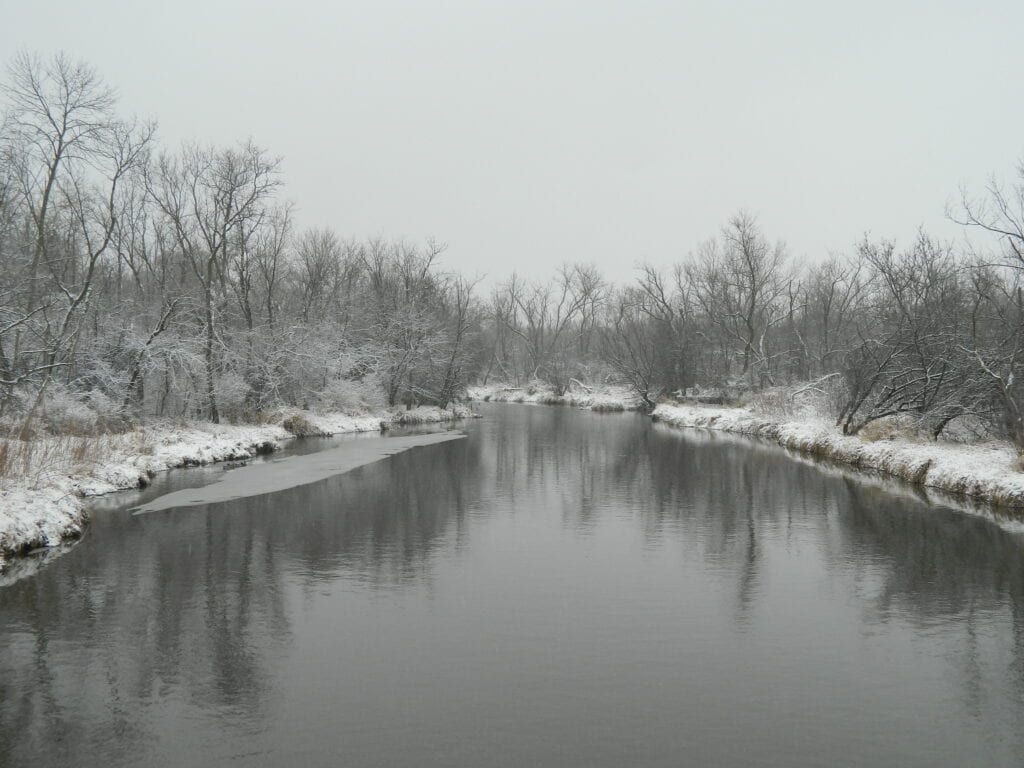And …..more on those nasty invasives …..

Snowfall on the unfrozen river in January. Again, invasive buckthorn can be clearly seen along the shoreline-(the low heavily flocked shrubs) plus super invasive Reed Canary grass dominating the shoreline, with floodplain tree species rising above. Off Geneva Rd, the west branch of the DuPage River.
From Wiki info:
Rhamnus cathartica is a deciduous shrub or small tree growing up to 10 m tall, with grey-brown bark and spiny branches. The leaves are elliptic to oval, 2.5–9 cm long and 1.2–3.5 cm broad; they are green, turning yellow in autumn, and are arranged somewhat variably in opposite to subopposite pairs or alternately. The flowers are yellowish-green, with four petals; they are dioecious and insect pollinated. The fruit is a globose black drupe 6–10 mm diameter containing two to four seeds; it is mildly poisonous for people, but readily eaten by birds, which disperse the seeds in their droppings.
The species was originally named by Linnaeus as Rhamnus catharticus.
The seeds and leaves are considered toxic to humans and animals, causing stomach cramps and laxative effects thought to serve a function in seed dispersal. The chemical compounds responsible for this laxative effect are anthraquinone[9] and emodin cathartica as the genus name Rhamnus is of feminine gender.
Rhamnus cathartica is shade-tolerant, moderately fast-growing and short-lived. It is a food plant of the Brimstone butterfly. The sulphur-yellow males are indicative of the plant’s presence.
Allelopathy-
Secondary compounds, particularly emodin, have been found in fruit, leaves, and bark of the plant which may protect the plant from insects, herbivores, and pathogens.[12] Emodin present in R. cathartica fruit may serve purposes of prevention of early consumption, as it is found most in unripe fruits, which allows seeds to reach maturity before being dispersed. Birds and mice significantly avoid eating unripe fruits, and if forced to ingest emodin or unripe fruit, the animals regurgitate the meal or produce loose, watery stools.
Allelopathic effects of exudates from R. cathartica leaf litter, roots, bark, leaves, and fruit may reduce germination of other plant species in the soil. Soils in buckthorn dominated areas are higher in nitrogen and carbon than normal soils, which speed up decomposition rates of leaf litter.This can result in bare patches of soil being formed and R. cathartica performs well in such disturbed habitats, so this may be adaptive for the setting of its seed.
The species is naturalised and invasive in parts of North America.[3][14][12] R. cathartica has a competitive advantage compared to native trees and shrubs in North America because it leafs out before native species.[15] The early emergence of their leaves in the spring and can shade out the growth of native plants. 27-35% of the annual carbon gain in R. cathartica comes from photosynthesis occurring before the leaves of other plants emerge. [9] Soil in woodlands dominated by R. cathartica was higher in nitrogen, pH, and water content than soil in woodlands relatively free of R. cathartica,[16][17] probably because R. cathartica has high levels of nitrogen in its leaves and these leaves rapidly decompose.
R. cathartica is also associated with invasive European earthworms (Lumbricus sp.) in the northern Midwest of North America.[18] Removing R. cathartica led to a decrease of invasive earthworm biomass of around 50%.[19]
Control methods[edit]
It is difficult to control because it sprouts vigorously and repeatedly from the root collar following cutting, girdling, or burning.[21] Herbicide application to newly cut stumps is a popular and effective control method. However, seeds stay viable in the soil for several years before sprouting, so repeated treatments and long-term monitoring of infested areas is required.[22] Garlon and Tordon, as well as their derivatives, have been found to be effective chemical means. Roundup can be used but is less reliable. [9] An application of these chemicals in early winter reduces the risk of negatively impacting non-target species, as most have gone dormant by this time. It is also easier to spot infestations at this time of the year, as its leaves stay out an average of 58 days longer than native plants.[9]
Mechanical control methods such as pulling and chopping of plants are more environmentally friendly, but also very time consuming. Plants with stems less than half an inch in diameter or less than a meter tall can easily be pulled, but pulling risks disturbing the roots of adjacent, native plants and harming them as well.[22] Propane-weed torches may also be used to kill seedlings and they will generally not re-sprout if burned in spring or early summer.[9]
